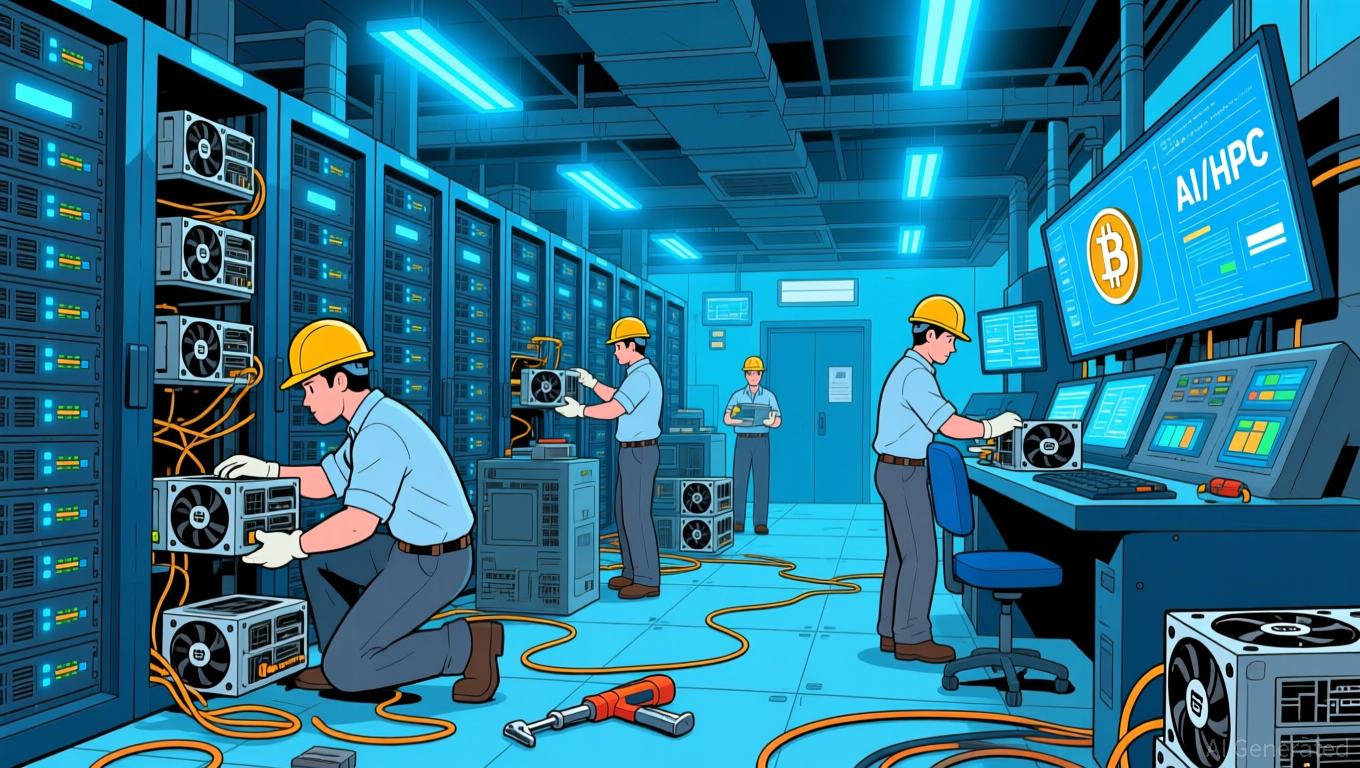Bitcoin News Update: As AI Sparks a Modern Gold Rush, Bitcoin Miners Shift Focus from Blocks to Bytes
- Bitcoin miners like CleanSpark pivot to AI/HPC as mining profitability declines, raising $1.15B for infrastructure expansion and share buybacks. - Industry peers TeraWulf and Core Scientific expand HPC capacity, shifting valuation focus to AI hosting revenue ($1.5-2M/MW/year) over hashrate growth. - Regulatory hurdles and GPU shortages challenge AI infrastructure scaling, but long-term demand projects U.S. data-center electricity use to hit 606 TWh by 2030. - Hybrid crypto-AI infrastructure becomes a sca
With profits from traditional Bitcoin mining shrinking, miners are rapidly branching out into artificial intelligence (AI) and high-performance computing (HPC).
This development follows Bitcoin mining difficulty reaching an all-time high of 155.97 trillion in late October 2025, marking a 6.31% increase from the previous adjustment. Meanwhile, hashprice revenue—the earnings per unit of computational power—fell to $41 per terahash per second (TH/s), approaching levels that threaten the survival of smaller miners,
CleanSpark’s $1.15 billion offering, increased from an initial $1 billion, carries 0.00% interest and a 27.5% conversion premium over its $15.03 share price at the time of announcement. Of the funds, $460 million will be used to buy back shares at $15.03 each, while the rest will go toward acquiring power and land, building data centers, and paying off bitcoin-backed credit lines,

This approach is similar to that of other companies like TeraWulf Inc. (WULF), which saw an 87% increase in revenue year-over-year in Q3 2024, fueled by both Bitcoin mining and AI/HPC services. TeraWulf’s Lake Mariner facility in New York now provides 22.5 MW of HPC capacity under long-term agreements with Fluidstack, supported by a $1.8 billion credit enhancement from Google,
The move toward AI is changing how mining companies are valued. Investors are now focusing more on contracted AI hosting revenue—ranging from $1.5 to $2.0 million per megawatt annually—rather than just hashrate growth,
Yet, obstacles remain. Regulatory issues, such as New York’s emissions reduction requirements for Greenidge Generation Holdings, underscore the importance of environmental compliance in AI infrastructure projects,
Experts point out that while Bitcoin’s price swings remain unpredictable, the transition to AI hosting provides miners with a cushion against the sector’s volatility. Marathon Digital Holdings (MARA), which acquired a 64% stake in EDF’s Exaion unit, and Iris Energy (IREN), which runs GPU clusters powered by renewables, are examples of the industry’s move toward more diverse revenue streams,
After CleanSpark announced its bond offering, its shares fell 4.9% in premarket trading, reflecting investor concerns about potential dilution from the convertible notes,
As Bitcoin miners contend with a bearish market, their shift toward AI marks a major transformation: facilities capable of supporting both ASIC and GPU workloads are becoming more valuable than raw hashrate alone. For CleanSpark and its competitors, securing access to power, land, and the electrical grid will be crucial for success as digital infrastructure becomes the backbone of both cryptocurrency and AI growth.
Disclaimer: The content of this article solely reflects the author's opinion and does not represent the platform in any capacity. This article is not intended to serve as a reference for making investment decisions.
You may also like
Bitcoin News Today: Bitcoin Miners Bet on AI: Will Technological Advances Outpace Market Fluctuations?
- Bitcoin miners adopt AI/HPC to offset bear market pressures, leveraging energy infrastructure for GPU workloads. - TeraWulf's $1.85M/MW/year AI hosting benchmark and CleanSpark's Texas campus highlight infrastructure diversification. - Grid constraints and GPU shortages challenge transitions, while Bitcoin ETF outflows ($558M) signal shifting investor sentiment. - Analysts warn of potential $100,000 price correction if $104,000 resistance fails, despite positive on-chain demand signals. - JPMorgan identi

Brazil Sets Sights on Crypto Regulation to Build Confidence and Strengthen Regional Leadership
- Brazil's central bank introduced Latin America's strictest crypto regulations, requiring VASPs to obtain authorization and comply with banking-level oversight by November 2026. - New rules mandate $2M+ capital requirements, classify stablecoin transactions as forex operations, and cap unapproved crypto transfers at $100,000 per transaction. - The framework aims to combat fraud and illicit finance by extending AML protocols to stablecoins, which account for 90% of Brazil's crypto activity, while enhancing

Argentina's LIBRA Controversy Exposes Connections Between Cryptocurrency and Politics Amid Worldwide Asset Freezes
- Argentina's federal court froze assets of LIBRA memecoin suspects, including U.S. founder Hayden Davis, over a $100M-$120M alleged pump-and-dump scheme linked to President Milei's endorsement. - Prosecutors allege Davis used Milei's influence to inflate the token's value, with $90M traced through exchanges like Bitget, including a $507,500 transfer 42 minutes after a presidential selfie. - The case highlights crypto-political ties, with texts suggesting Davis claimed control over Milei's decisions and pa

Ethereum News Update: BitMine's ETH Acquisition Echoes MicroStrategy While Institutional Holdings Fuel Supply Shortage
- Ethereum's circulating supply hits 12-month low as BitMine Immersion (BMNR) accumulates 2.9% of total ETH, becoming the largest institutional treasury. - SharpLink Gaming's staking activity and BitMine's aggressive buying drive supply contraction, with $13.2B in crypto holdings and $398M earmarked for further acquisitions. - Despite 15.94% weekly price decline, Ethereum sees $12.5M ETF inflow ending six-day outflow streak amid volatile on-chain activity and macroeconomic uncertainty. - SharpLink clarifie
